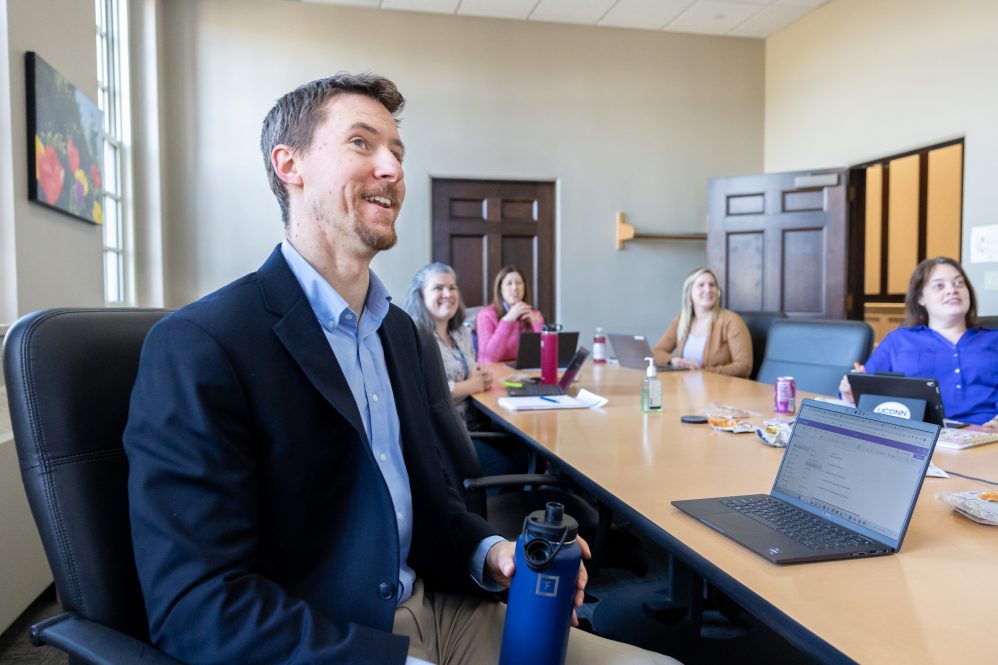Every semester, some UConn students inevitably encounter the stressful situation of finding a hold on their student administration system account, preventing them from completing tasks like registering for classes. Naturally, these students might begin to ask themselves what the hold is for, how to resolve the issue, and if it could affect their financial aid.
Perhaps the most important question, though, becomes: who do I contact for help?
Michael Ormsby, the newly hired director of One Stop Student Services, is working to create a place where students can get answers to all of these questions and more.
“We want to get more done in one place for students,” says Ormsby.
The One Stop Student Services Office, expected to open in Spring 2024, will be the front-facing customer service center for the Offices of the Registrar, Student Financial Aid Services, and Undergraduate Admissions under the Division of Enrollment Planning & Management. Initial contact points for these areas, including the general University phone number currently routed to the registrar, will be redirected to One Stop.
“Rather than having to decide as a student what questions apply to which offices, we want to do that work for the student,” Ormsby explains.
‘We’re Always Trying to Elevate the Level of Service for Our Students’
While the office will focus on concerns related to the registrar, financial aid, and admissions, Ormsby emphasizes that they won’t turn away questions, but will work and communicate with leaders in other areas to respond to needs appropriately.
Offices like the registrar and financial aid, meanwhile, will still exist and perform their respective functions, but One Stop will bring together certain staff from these different areas into one location. This design is intended to help resolve issues like being transferred to different offices, or initially calling the wrong office.
“When staff with different expertise are in the same room together, those people are learning [from each other] and they can provide answers faster,” says Ormsby. “They have a broader understanding of what the student is trying to accomplish and can pool resources quickly for more comprehensive responses.”
Ormsby ultimately envisions a model where staff will be trained in multiple areas, so they can answer various questions in one conversation. Vice President for Enrollment Planning & Management Nathan Fuerst says this training will be ongoing and occur seasonally, such as ahead of registration periods. Fuerst and his team began investigating the one-stop model in 2019-2020, before the COVID-19 pandemic.
“It began with a loose question about ‘how would this work if the University were to do it?’— in part because other institutions were doing similar things,” Fuerst says. “But also, we’re always trying to find ways to elevate the level of service for our students. When we hear a student didn’t necessarily get access to the information they needed in a timely manner, or had to visit multiple offices to get a matter resolved, the question that we ask ourselves is ‘What are the alternatives— could we do this a better way?’”
As operations for the offices normalized after the initial need to adjust in the face of the pandemic, Fuerst and his team worked with a partner to assess and create a plan for implementing One Stop at UConn. Hiring Ormsby as director was the first step.
Instead of Waiting for Questions, Giving a ‘Nudge’
Fuerst explains that implementing One Stop also requires rethinking the traditional service model, where staff sit on one side of a desk while students stand on the other.
“We know that, even in generational differences alone, it’s a dated model,” says Fuerst. “For example, our students are continuing to engage with us virtually through things like chat and email and other mediums. So the conventional way that we have handled inquiries that have come our way— we want it to evolve, and we want it to evolve in the direction where we see our students being.”
Fuerst and Ormsby recognize that today’s students and families have different inquiries and lived experiences compared to when college and universities first created their service models. As a result, One Stop seeks to serve diverse populations of students and meet their changing needs.
“I think about first-generation students, [and] just the understanding of what a financial aid office does versus an admission office versus a bursar,” Ormsby says. “Having an understanding of those terms and a general idea of what they mean— there’s a drastic difference between a student who has family members or support systems that know that information and can try to express that for a student versus someone that doesn’t. The One Stop model can help in that process. We can help be the educators.”
Part of this education will involve proactive work. Instead of waiting for students to ask questions, One Stop will “give students a nudge,” says Ormsby.
“We’re anticipating that these students who haven’t already registered for classes might benefit from some type of outreach, as an example,” Fuerst explains. “Or, these students who submitted their financial aid application last year are likely to do so again this year. What kind of outreach would be beneficial to them?”
In the coming months, Ormsby is looking forward to building One Stop’s staff, getting initial feedback from students once the office opens, and identifying what other student needs he and his staff can address. Ultimately, Ormsby hopes that One Stop will help make students’ lives easier and be a place where they feel taken care of.
“Students have a lot to focus on, in terms of studying and making sure that they’re doing the work in the classroom,” Ormsby says. “We need to do whatever we can to try and relieve pressure and stress in other areas.”



